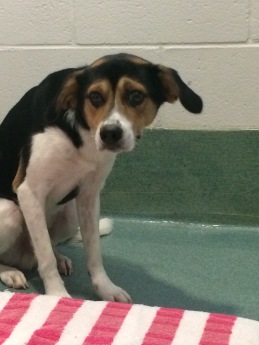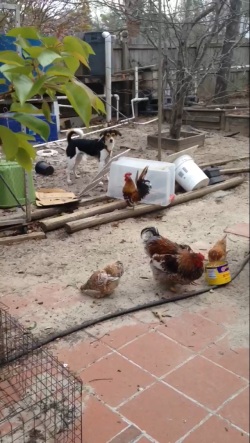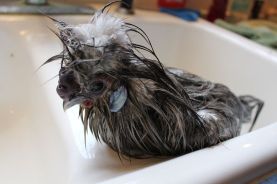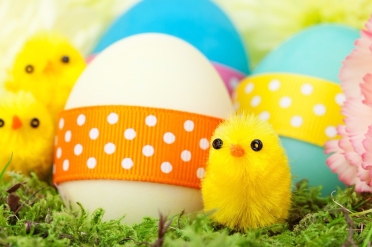For all of us that love our feather babies, we tend to love our fur babies just as much! Though, it can be hard to raise chickens and keep a dog when they haven’t been raised together! I speak from experience. Both my dogs, Cashew and Toby took a lot of work before they could be trusted around the chickens without myself around. I want to share my experience with training them and the tips that I came up with!
Now things are A LOT easier when you have the dog from a pup when it comes to teaching your pets that chickens are friends, not food! But, if you’re like me then you spend way too much time on the SPCA website and the website for your local kennel. Next thing you know, you’ve done chicken math with dogs…
When you have your dog from puppyhood, keeping them around the chickens as much as possible! A friend of mine had a lab puppy and chicks at the same time and they were raised together. Now it’s hard to tell if the chicks think they’re a dog or if the dog thinks he is a chicken! Show your dog that chickens aren’t harmful to them or you. If you have an especially aggressive rooster, it is best to keep your puppy away and not introduce those two until he’s older. Hopefully, the size of the dog would deter your rooster from picking a fight, but we’ve all seen the ones that would fight a tank. For those roosters, I suggest you remove the spurs because they can do serious damage to you and your pets. If you live in an area where you need your rooster to protect your flock from predators you may not be able to keep out (i.e. hawks, opossums, weasels) keep the spurs but be extra careful!
I did not get the chance to train my dogs from puppyhood so it was a lengthy process. Cashew was the first dog we had and he was afraid of his own shadow.  He came to us from the shelter. Before that, he was abused and malnourished. He wouldn’t even look me in the eyes, but after sitting with him for a few hours, he finally let me pet his nose and I was sold. Cashew is a beagle – rat terrier mix (we think?) so his hunting instincts were decently sharp. When he first saw the chickens he would chase them until he had them pinned. If your dog is like Cashew, here are a few tips for training him for your chickens:
He came to us from the shelter. Before that, he was abused and malnourished. He wouldn’t even look me in the eyes, but after sitting with him for a few hours, he finally let me pet his nose and I was sold. Cashew is a beagle – rat terrier mix (we think?) so his hunting instincts were decently sharp. When he first saw the chickens he would chase them until he had them pinned. If your dog is like Cashew, here are a few tips for training him for your chickens:
- Find a safe space your dog loves (for Cashew it was his crate) and while having someone hold your pup, bring your most docile bird to him. Hold him steady and let the bird just walk around him. We put cash in his crate and then let the chicken walk around him.
- Make sure they interact every day! Whether it’s just a brief walk past the coop every day (on a leash!) or bringing a chicken close to him, it is important to get your pup use to them!
- Feed your pup and chickens close together. Bring your dog’s food bowl out to the coop so he can see them while he eats and sees that they are not bothering him while he eats.
- Walk around your house doing everyday activities…holding a chicken. Pick your best guy or girl and bring her in for the day! I recommend a diaper to prevent any messes though. Brining a chicken into the home and allowing your pup to see how you interact with it will allow him to see that chickens are not dangerous and you enjoy having them near you just as you enjoy having your pup!
 Again, these are just some recommendations on how to get your dog use to your chickens when they are no longer puppies or entering your family as a rescue. While you should first make sure that your dog is comfortable in his new home before starting any type of intensive training, most dogs pick up pretty quickly! You should not trust your dog to remain outside alone with your birds until you have been able to walk him, off-leash, near your birds with little to no interest in your birds.
Again, these are just some recommendations on how to get your dog use to your chickens when they are no longer puppies or entering your family as a rescue. While you should first make sure that your dog is comfortable in his new home before starting any type of intensive training, most dogs pick up pretty quickly! You should not trust your dog to remain outside alone with your birds until you have been able to walk him, off-leash, near your birds with little to no interest in your birds.
My newest pup, Toby, still needs work to go near our birds. He lives with me at school and only sees the birds every month or so, Cashew, who stays with my parents, after six months of intensive training, now stays outside with the chickens, weather permitting, and acts as their guardian from other prey. He has come a long way but it took time, so please be patient with your pup and the results will come!



 Since their feathers are so fine, you have to be cautious about the rain, they get soaked easily and then they get cold. A soaking wet silkie is both adorable and sad. However, they’re lovers of baths and the blowdryer. They are feathered all over, even to their feet, so when left outside they do become dirty pretty easily. They will lay about 180 eggs a year and the males are also nonaggressive but they crow just as loud as any other rooster. These are the bird for you is you’re looking for easy care and a unique look. They have very sensitive heads (gotta support that fro) So please be wary when they are chicks not to let other chicks peck them on the head and do not tap them on the head.
Since their feathers are so fine, you have to be cautious about the rain, they get soaked easily and then they get cold. A soaking wet silkie is both adorable and sad. However, they’re lovers of baths and the blowdryer. They are feathered all over, even to their feet, so when left outside they do become dirty pretty easily. They will lay about 180 eggs a year and the males are also nonaggressive but they crow just as loud as any other rooster. These are the bird for you is you’re looking for easy care and a unique look. They have very sensitive heads (gotta support that fro) So please be wary when they are chicks not to let other chicks peck them on the head and do not tap them on the head.













